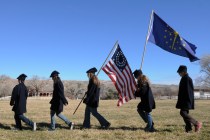Tours of Grand Canyon Caverns delight visitors
Discovered in 1927, Grand Canyon Caverns in Northern Arizona celebrates 80 years of subterranean adventure this year. Open daily except Christmas Day, the usual dry limestone caverns located near Historic Route 66 attract thousands of visitors annually. They arrive by traveling a portion of the old Mother Road between Kingman and Seligman.
The caverns lie 165 miles from Las Vegas using U.S. 93 over Hoover Dam into Arizona to reach Kingman, 103 miles distant. In Kingman, watch for the Historic Route 66 signs and head east 62 miles to the short spur road accessing the caverns. The two-lane highway cuts through scenic high desert, ranch country and hills forested with pinyons and junipers. Unlike busy Interstate 40, the main highway, Historic Route 66 carries light traffic and no trucks.
Visitors today enjoy a choice of guided underground tours in this commercially developed underworld millions of years in the making. Appealing to the greatest number of visitors, the regular 45-minute tour leaves every half-hour. It involves some walking and stair-climbing. This tour costs $12.95 for adults and $9.95 for children aged 4 to 12. An abbreviated tour suits those with time constraints or physical limitations. A hard-hatted, off-trail explorers' tour limited to no more than six visitors reaches other portions of the caves.
A young woodcutter for the Santa Fe Railroad, Walter Peck, discovered a small cavern entrance in 1927 when he investigated a saddle and two skeletons inside a shallow opening in the rocks. Local Hualapai people laid to rest two brothers who died of Spanish influenza during the terrible pandemic of 1918. At that time, a large boulder blocked the cavern entrance. By the time Peck stumbled upon the funeral site, the boulder had fallen through into the cavern below.
Peck returned with some friends, lanterns and lengths of rope. They lowered a young cowboy into the unknown depths, feeding out 150 feet of rope before he reached the bottom of a large room. His light reflected on crystals that he thought were gold. He carried some samples back to the surface.
Assays later proved the sparkling stone to be calcite colored by iron oxide, but Peck had already bought the property and filed mining claim in anticipation of his "gold" strike in the cave that he dubbed Yampai Cavern. Newspapers sensationalized the discovery of the caverns and the human remains. Soon the public read about two "cavemen" with no mention of the saddle. People clamored to see the burial site and the caverns.
Determined to recoup some of his investment, Peck began to charge a quarter for those adventurous enough to visit his caves. Visitors flocked there on Route 66, then a gravel road. Early visitors had to squeeze through the natural entrance and go down singly by rope, supplying their own light. It was not a trip for the faint of heart.
In 1935, locally stationed Civilian Conservation Corps workers took on improving access to the caverns as a project, with Peck supplying the materials. The CCC boys constructed a 30-foot wooden stairs, three 15-foot ladders and 70 feet of swaying suspension bridge to get visitors into the caverns. Visitors had to have nerve and stamina, but more of them could see the caverns, traveling on a widened, paved Route 66. Peck upped the fee to 50 cents.
Construction of a 210-foot shaft made possible the installation of a 21-story elevator in 1962, a few years after the caverns acquired a kitschy new name, Dinosaur Caverns, despite the absence of any dinosaurs. The developing interstate system supplanted highways like Route 66, bypassing many little towns and roadside attractions like the caverns. The elevator still transports visitors safely and comfortably, though the price and the name have changed again.
Today's visitors find the caverns contain an unintended time capsule. Still stockpiled in one of the largest chambers are food, water, medical supplies and toilet paper for 2,000 people, a result of the nation's effort to find safe havens and bomb-proof shelters during the Cold War. The dry air of Grand Canyon Caverns preserves the hoard untouched decades later.
Margo Bartlett Pesek's column appears on Sundays.
MARGO BARTLETT PESEKMORE COLUMNS






















